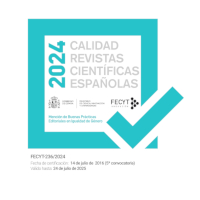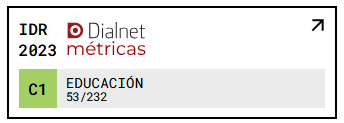El cine como estrategia didáctica innovadora. Metodología de estudio de casos y perfil de estrategias docentes
DOI:
https://doi.org/10.18172/con.529Keywords:
Didactic strategy, Formative cinema, Innovation, Study of cases, Profiles strategy, Development MethodologyAbstract
The present study is comprised in an ampler cradle investigation based on the integration of three concepts, usually studied separatedly (Research, Training, Innovation), in order to improve the quality of education thanks to the study of didactic strategies. Models’ based reflection has not been effective for a teaching change as well as those that have been kept in the mere practice, out of the context of the work place. Thus, this investigation tries to give joint sense to these three concepts: knowledge generation, training and innovation. Didactic strategy concept (Torre, 1997, 2000) is defined based on its six components: theoretical perspective, purpose or pursued aim, adaptative character, contextual reality, implied people and organizational aspects, functionality and effectiveness. Holodynamic analysis model is described in the classroom context (Torre, 2003) considering eight parameters: teacher’s implicit assumptions, context, teacher rol, pupil rol, resources, time and space organization, interaction and evaluation. These are the indicators taken into account in the described study of cases using commercial cinema as informative support and the profiles as representation technique. The formative cinema is a strategy that has been used for ten years as much in annual forums as in classrooms by GAD group of the University of Barcelona. On the other hand, the technique of representing by profiles complex qualitative information facilitates the global understanding of the strong and weak points of the teaching improvement.Downloads
References
BARNETT, R. (1995). Improving higher education. Total quality care. Buckignham: Open University.
BIREAUD, A. (1990). Les méthodes pédagogiques dans l’enseignament supèrieur. Paris: Organisation.
CARAMÉS, J.L. (2000). La nueva cultura de la universidad del s. XXI. Oviedo: Trave.
COHEN, L y MANION, L. (1990). Métodos de investigación educativa. Madrid: La Muralla.
Comisión de Docencia (1995). Didáctica universitaria. Sevilla: Publicaciones Universidad Sevilla.
DAVIDSON, J. (2000). La gestión del tiempo. Madrid: Prentice Hall.
DE VICENTE, P. (Coord.) (2002). Desarrollo profesional del docente. Bilbao: Ice-Deusto.
DEL RINCÓN, D.; ARNAL, J. y LATORRE, A. (1995). Técnicas de investigación en Ciencias Sociales. Madrid: Dykinson.
ELINS, N. (1989). Tiempo y espacio. Revista Educación, 298.
ENTWISTLE, N. (1988). La comprensión del aprendizaje en el aula. Barcelona: Paidós.
FERRER, V. (1994). La metodologia didáctica a l’ensenyament universitari. Barcelona: Universidad de Barcelona.
GARCIA-VALCÁRCEL, A. (Coord.) (2001). Didáctica Universitaria. Madrid: La Muralla.
GIBAJA, R.R. (1993). El tiempo instructivo. Buenos Aires: Aique.
GONZÁLEZ, A.P. (Coord) (2002). Enseñanza, profesores y universidad. Tarragona: ICE-URV.
HENNINGS, D. (1987). El dominio de la comunicación educativa. Madrid: Anaya.
JOYCE, B y WEIL, M. (1985). Modelos de enseñanza. Madrid: Anaya.
LATORRE, A.; DEL RINCÓN, D. y ARNAL, J. (1996). Bases metodológicas de la investigación educativa. Barcelona: Hurtado.
MARCELO, C. (1995) Desarrollo profesional e iniciación a la enseñanza. Barcelona: PPU.
MEC (1993). Monográfico sobre Tiempo y espacio. Revista de Educación, 298.
OLIVER, C. (2003). Estrategias didácticas y organizativas ante la diversidad. Barcelona. Octaedro.
PÉREZ SERRANO, G. (1994). Investigación cualitativa. Madrid: La Muralla.
ROMERO, C. (2000). El conocimiento del tiempo educativo. Barcelona: Alertes.
SNEDDON, I. y KREMER, J. (Eds) (1994). An interprising currículo. Belfast: Hmso.
STAKE, R. (1999). Investigación con estudio de casos. Madrid: Morata.
TEDESCO, J.C. (1997). Uso del tiempo en la sala de clases. Información e innovación en educación. OIE.UNESCO, 92.
TEJADA, J. (2000). El docente innovador. En Torre, S. y Barrios, O. Estrategias didácticas innovadoras. (2ª ed., 2002), 47-61. Barcelona: Octaedro.
TEJADA, J. (2000b). Perfil docente y modelos de formación. En Torre, S. y Barrios, O. Estrategias didácticas innovadoras. (2ª ed., 2002), 16-46. Barcelona: Octaedro.
TEJADA, J. (2002). El docente universitario ante los nuevos escenarios: implicaciones para la innovación docente. Acción Pedagógica, 11 (2), 30-42.
TORRE, S. DE LA (2003). Diseño de la investigación y análisis de resultados. Documento Mimeo. Barcelona.
TORRE, S. DE LA (Coord.) (1996). Cine formativo. Barcelona: Octaedro.
TORRE, S. DE LA (1997). Innovación educativa. Madrid: Dykinson.
TORRE, S. DE LA (Coord.) (1998). Cine para la vida. Barcelona: Octaedro.
TORRE, S. DE LA (Coord.) (2001). Aprender del conflicto en el cine. Barcelona: PPU.
TORRE, S. DE LA y BARRIOS, O. (2000). Estrategias didácticas innovadoras. Barcelona: Octaedro.
TORRE, S. de la (2003). Dialogando con la creatividad. Barcelona: Octaedro.
UNESCO (2000). L’educació superior en el siegle XXI. Barcelona: UNESCO.
VILLAR, L.M. (1999). Construcción y análisis de procesos de enseñanza: Teoría e investigación. Barcelona: Oikos Tau.
Downloads
Published
How to Cite
Issue
Section
License
The authors retain copyright of articles and authorize Contextos Educativos. Revista de Educación the first publication. They are free to share and redistribute the article without obtaining permission from the publisher as long as they give appropriate credit to the editor and the journal.
Self-archiving is allowed too. In fact, it is recommendable to deposit a PDF version of the paper in academic and/or institutional repositories.












